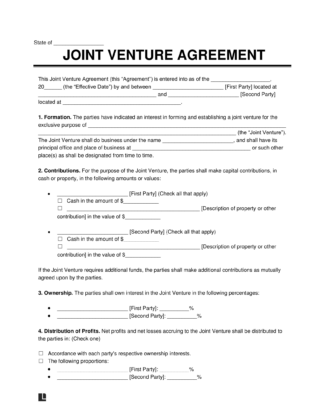
Use our joint venture agreement to create a contract between parties who want to do business together.

Updated December 18, 2023
Written by Sara Hostelley | Reviewed by Brooke Davis
A joint venture agreement is a written contract outlining the circumstances of two parties pursuing a business activity or project. This agreement details the arrangement between separate entities (often with interrelated strengths) who combine their resources, capital, and expertise to accomplish a common goal.
Instead of creating a formal partnership or new legal entity, a contractual joint venture (JV) allows the parties to continue filing their tax returns separately yet still reap the financial advantages of a partnership, such as sharing resources and risks.
A well-written joint venture agreement clarifies each party’s expectations, responsibilities, and rights relating to the venture.
When both parties execute a joint venture agreement properly, it’s legally binding. If one party doesn’t uphold their end of the agreement, the other party can initiate legal action against them.
Some elements that make this written agreement legally binding include the following:
It identifies the following fundamental elements:
Joint ventures have a limited life and purpose, requiring less commitment than a more permanent type of partnership that imposes more responsibilities and obligations on each partner.
Here are some defining characteristics of a joint venture:
The involved entities might agree to end a joint venture when:
Explore some of the benefits and risks of forming a joint venture:
Explore the steps to forming a joint venture so you can decide if this path is right for your existing business:
Find a suitable partner who complements your company’s existing structure. For example, suppose your business developed an innovative new product, but you don’t have adequate distribution channels. You might look for a business partner with established channels and a good industry reputation.
Contact different distributions to assess their interest in partnering with you. Ensure you trust the company leaders you choose, evaluating their skills, industry expertise, and cultural fit. When you conduct this due diligence, you can have more confidence in your chosen partner.
Here are some elements to consider about a potential partner:
Once you find a partner, you can negotiate with them to decide on the type of joint venture you’d like to start. Consider the two types:
Creating a separate legal entity is more complex and expensive, but it can offer more legal protection if an issue arises. A simple contractual agreement allows for more flexibility, as the parties don’t have to pay taxes and report profits for an entirely new entity. Instead, the profits flow through to each party’s business.
Use our joint venture agreement template to start drafting your own document. Tailor it to your and your partner’s needs and preferences. Negotiate with the other party to ensure you detail mutually beneficial terms.
While drafting and signing this document, you should have legal representation for each party. A third party with legal knowledge for each entity can ensure the document is fair and legally enforceable.
No matter what kind of profit-seeking business you have, you must pay your share of taxes. The same applies to owners of joint ventures. The taxes you pay for your joint venture will depend on how you structure your arrangement.
If you and your partner create a separate entity, all its profits will be subject to taxation based on the business type. For example, C corporations pay a tax rate of 21% on profits they earn. Alternatively, limited liability companies (LLCs) account for business losses and income on each owner’s individual tax return.
Contractual joint ventures don’t file their own tax returns. Instead, their tax responsibilities flow to each party’s respective entity.
Ensure you abide by federal, state, and local laws for your joint venture’s activities. For example, if you plan to use the labor of another entity’s employees as part of your joint venture agreement, you must follow applicable labor laws.
You might also need to acquire a business license or permit to legally operate, depending on the industry to which your joint venture belongs.
Here are some alternatives to a joint venture you may consider:
A partnership is a business structure in which two or more parties lead a company together. They share the business’s profits and losses. It lasts indefinitely, unlike a joint venture that usually has an end date.
The main similarity between a partnership and a joint venture is that each party often shares liability if something goes wrong.
A franchise is when a parent company grants an individual the right to operate a business using the parent company’s brand and approaches. Some examples include Dunkin Donuts, Ace Hardware, and The UPS Store.
The business purchasing the franchise pays a fee to the franchisor to obtain operating rights. The franchisor will maintain some control over how the franchisee conducts their business. Alternatively, neither party is in complete control in a joint venture, as both contribute their ideas and resources toward a common goal.
Licensing involves a licensee obtaining the right to use a company’s intellectual property to perform services to make products.
It’s similar to franchising but offers more freedom to the licensee, as the licensor doesn’t have much control over how the licensee conducts their business.
A merger occurs when two companies unite to become one entity. It takes place when two companies of similar size mutually agree to come together. They remain one entity for an indefinite period.
An acquisition occurs when a larger company assumes a smaller company’s assets. A larger company performs an acquisition when it has the resources to buy out a smaller business.
Download a joint venture agreement template as a PDF or Word file below: